|

|
Consultancy & Special Projects
Africa
|

|
|
EGYPT
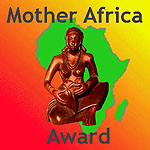
|
|
|
|

|
|
|
Official Name
|
Jumhuriyet Misr al'Arabiya
|
|
Located
|
North: Libya, Sudan
|
|
Capital
|
Cairo
|
|
Head of State |
President Hosny Mubarak
|
|
Area
|
997,738 sq km
|
|
Population
|
61.5 million
|
|
Growth rate
|
2%
|
|
Languages
|
Arabic, English & French
|
|
Currency
|
Egyptian pound
|
|
GNP per capita
|
$3,820
|
|
Inflation
|
11%
|
Airlines
(advertise here)
|
from Europe: ________________
from Asia: ________________
from USA: ________________
|
Hotels
(advertise here)
|
Names & Rates per night
______________________
______________________
|
|
USAfrica Agent
|
________________
|
|
Country Advertiser
|
If you want to become
the Country Advertiser
your logo comes here.
|
|

Minarets by night
©2001-2002: Tourist Office
|

Tutankhamun
©2001-2002: Tourist Office
|
|
|
Egypt is the birthplace of one of the greatest civilizations the world, which flowered three thousand years before Christ, leaving us the pyramids and temples around Luxor and Aswan. Giza’s pyramids are considered to be one of the Seven Wonders of the World. Who hasn’t heard of the Tutankhamun treasures at the Egyptian Museum in Cairo, the Great temple of Abu Simbel, the Valley of the Kings and of course CLEOPATRA VII - QUEEN OF EGYPT. Cleopatra is renowned for her relationship to Julius Caesar & Marc Anthony around 47 BC. On mount Sinai, Moses received the Ten Commandments.
|
|
Hurghada (Al-Ghardaka) is the number one tourist area at the South coast of the Gulf of Aqaba and features some of the world’s most amazing underwater scenery.
|
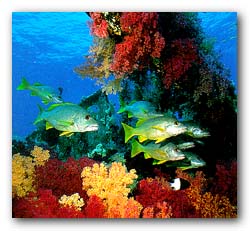
©2002: Tourist Office
|
|
Suez Canal:
The Suez Canal is one of the greatest feats of modern engineering and links the Mediterranean with the Red Sea. Western desert oases are attracting a growing number of travelers. One of the man-made wonders of Africa, the High Aswan dam, which holds Lake Nasser, is situated on the Nile River. The Aswan High Dam is located in southern Egypt near the city of Aswan on the Nile River. It is one of the largest reservoirs in the world. Construction took place between 1960 and 1968. During the construction great care was taken to preserve and re-site the treasures of ancient Egypt that would have been lost under the waters. The giant lake created by the dam is called Lake Nasser after the then Egyptian president Gamal Abdel Nasser.
River Nile:

The Great Pyramid
©2001-2002: Tourist Office
|

Valley of the Kings
©2001-2002: Tourist Office
|
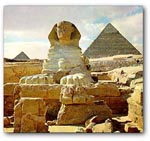
Spinx
©2001-2002: Tourist Office
|
|
|
The Nile is longest river in the world and is 6670 kilometers (4145 miles) long. The main tributaries are the Blue and White Nile rivers. The Nile delta is famous as the cradle of the first civilization of Africa - ancient Egypt, the most famous wonder of the world - the Great Pyramid, the birth place of Moses, and the first (papyrus) paper. The Great Pyramid of Egypt, built by Pharaoh Khufu (Cheops) in 2650 BC, is the greatest wonder of the ancient world and the only ancient wonder remaining today. The Great Pyramid was built from an estimated 2,300,000 blocks weighing around 2,5 tons each, over a period of 20 years. Its height was 146 meters (480 feet) when originally built. The angle of its sides is 51 degrees 51 minutes. Each side is orientated exactly due north, south, east and west. It contains many others interesting facts such its position at the center of all the landmass of the earth. The Pyramids of Meroe lie in Sudan, about 160 kilometers (100 miles) down the Nile from modern Khartoum. Meroe was the capital city of Kush (ancient Ethiopia). The king of Kush, King Pianky, conquered Egypt in 725 BC and gave Egypt its 25th or "Ethiopian" dynasty. Meroe was the greatest center of iron smelting industry in Africa in its time. Smelting works on a gigantic scale produced mountains of iron slag. An archaeologist described Meroe as "the Birmingham of ancient Africa".
|
Cairo:
|
Cairo is the largest city in Africa with over 7 million inhabitants. In Arabic, it is known as Al-Qahirah, or 'the victorious.' Cairo is an old city, having stood over 1000 years at its present location under the same name. However, the old and the new present sharp contrasts in this city. A large portion of ancient structures still exists in and around Cairo today. The most famous of them are undoubtedly the Pyramids of Giza and the Sphinx. Tourists and historians alike still flock today, thousands of years after it was built, still trying to uncover more of their mysteries. In all, Cairo contains more than 400 registered monuments. In the Fatimid city lies a large number of monuments like the Mosque of Baybars I and Saladin's Citadel. The downtown area Al-Azbakiyah is modern, with elegant buildings and present a sharp contrast with the older areas. The city's architecture reflects the diversity of style, with modern styles intermingling with ancient Egyptian, Roman, medieval Arab and Turkish styles. The city is fan-shaped; narrow at the south and widest in the north where the valley opens up in the Nile delta.
|

Cairo
©2002: Tourist Office
|

Port Said
©2002: Tourist Office
|
|
Economy:
Life in the country depends entirely on theRiver Nile and the thin strip of fertile land that borders it as far as the delta. The rest of the country, or 95% of the territory, is desert. The population density along the banks of the Nile reaches 1,200 inhabitants per sq km. The climate is very hot and dry in the south, is less extreme in the north where the main cities are. Cairo is the capital, and Alexandria the main port. Agricultural land is very fertile, and apart from subsistence farming, the main crop is cotton, which is of a very high quality. Other crops are linen, citrus fruits, legumes, sesame, rice maize and sugar cane. 50% of the labour force is employed in agriculture. There are practically no mineral resources, apart from a small amount of phosphates and some petrol from Sinai. Egypt is not a member of OPEC, as it does not export petrol. The hydro-electric scheme at the Aswan dam produces enough electricty to supply the needs of the country. Some income is derived from the Suez Canal. Tourism is a very important item in the economy, although it is subject to fluctuations and follows the political situation.
The population growth poses an enormous problem for the country, which has very little available space in spite of its size.
History:
Egypt came under the influence of Greece and Rome, before being converted to Islam in 639 AD. After a few centuries as first a French and then a British colony, it gained its independence in 1951-1952. Egypt occupies a very important geographic position, between Africa, Asia and Europe. It has closened its ties with Europe, especially France and Italy. While it has opened towards Saudi Arabia, its relations with Libya under president Qaddafi have deteriorated.
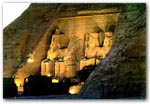
Abu Simbel
©2002: Tourist Office
|
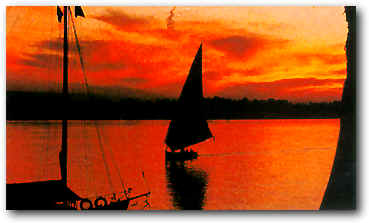
Assyut
©2002: Tourist Office
|
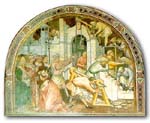
Alexandria
©2002: Tourist Office
|
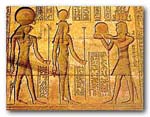
Luxor
©2002: Tourist Office
|
In 1952 a military coup d’etat by General Neguib overthrew the monarchy, but the “Free Officers Movement” soon became so radical that in 1954 Colonel Abd’el Nasser took over the reins of power. The personality and work of this man profoundly changed the evolution of the country. Known as the “Rais” he attacked what was left of capitalism in his country. Nasser led a constant war against Israel, helped by the Soviet Union which supplied Egypt with large quantities of weapons, materials and technicians. In spite of this, Egypt was defeated in 1956 and in the “Six Day War” of 1967. Between the war in 1967 and Nasser’s death in 1970, there was an arms race in the Middle East which culminated in the war of 1973, which saw a partial Arab victory. In 1975 Israel returned part of occupied Sinai (including the pertol fields of Abu Rodeiss and the strategic Miltla Pass) to Egypt. The death of Nasser opened the way for the new Rais, Anwar Al Sadat, to put in place his policy of “infitale” (opening), which was a return to a form of liberalism. The declaired aim was to favour private initiative, both local and foreign. For the peasants or fellaheen, “infitale” was an agrarian reform in favour of the landowners. For the workers in towns, “infitale” brought in a form of rationing, and there were incidents of civil unrest.
Boutros Boutros-Ghali:
Boutros Boutros-Ghali was born in Cairo to a prominent Coptic Christian family in 1922. His grandfather, Boutros Pasha Boutros-Ghali served as prime minister of Egypt under the British protectorate from 1908 until his assassination in 1910. Mr. Boutros-Ghali holds a Bachelor of Laws degree, received from Cairo University in 1946, as well as a Ph.D. in international law from Paris University in 1949. His thesis was on the study of regional organizations. He was appointed professor of International Law and International Relations at Cairo University in 1949 until 1977. He became the president of the Centre of Political and Strategic Studies in 1975 and the president of the African Society of Political Studies in 1980. He was a member of the Central Committee and Political Bureau of the Arab Socialist Union. Mr. Boutros Boutros-Ghali left his teaching post in 1977 to serve in the government of Egyptian President Anwar al-Sadat as a minister of state for foreign affairs and then as Egypt's deputy prime minister until 1991. He accompanied Egyptian president Anwar al-Sadat on Sadat's historic trip to Israel in 1977 and played a major role in the Camp David talks that led to the 1979 Arab-Israeli peace accord. Mr. Boutros-Ghali has received awards and honours from 24 countries. Nominated by the UN Security Council in November 1991 to become the UN's sixth secretary general, he was both the first African and the first Arab ever nominated to that post. He succeeded Javier Pérez de Cuéllar of Peru on January 1, 1992, for a five-year term. Boutros-Ghali faced a difficult tenure as head of the UN, however. His term in office began in 1992, when the world was reorganizing politically in the wake of the Cold War. His tenure as UN sixth secretary general ended in 1996.
Enabling us to improve the quality of the content, if you have additonal information, remarks or suggestions, please share it with us by e-mail.
Last update: 24 April 2008
|
|











